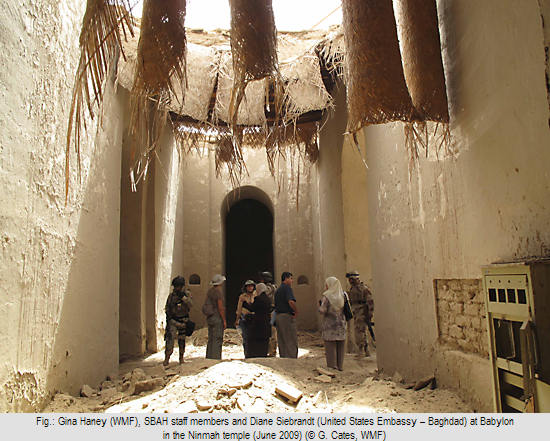The project is intrinsically about archaeology AND about conflict.
Conflict is defined as a "prolonged armed struggle". As we know, a coalition led by the US army invaded Iraq in 2003 and between March 2003 and December 2004, Babylon was home to military units of the Coalition Forces.
Conflict can also be defined as a serious disagreement or argument. Within the context of Babylon, the discussion of which entity has legal jurisdiction over the site is now occurring. In accordance with the Law for the Antiquities and Heritage of Iraq [1], the SBAH is the clear overseeing body. With credit to the Law of Governorates Not Incorporated into a Region [2], the Governorate of Babil acts today as holding power when making decisions about Babylon.
Conflict is also an incompatibility between perspectives, requirements, desires, and approaches. Saddam Hussein envisioned Babylon as a touchstone for his power, a place where he would reinvent and align himself with the likes of Hammurabi and Nebuchadnezzar. Today, the SBAH envisions the site as a number of compatible and seemingly incompatible things, a fragile piece of Iraq's most important history, a research laboratory for scientists from around the world as well as a tourism attraction. For the local administrators, Babylon is mainly a cultural resort to call investors and tourists, and a source of money.
Babylon is both a place of conflict, and a conflicted landscape. Excavated and exposed ancient remains, well-worn footpaths, Saddam Hussein-era reconstructions and palaces, various types of military barrier fencing and vast archaeological frontiers serve to define the site. Making sense of it is not easy. Nor is the process of engaging stakeholders with the hope that they will agree on, help to create, own and implement the said management plan.
Since June 2009, WMF has consistently completed missions to Babylon. Prior to these missions, WMF facilitated various meetings outside Iraq with the SBAH, and directives and priority areas on and in which WMF was to focus were agreed.

Engaging local government
One of the more challenging aspects of the project has been finding a common ground between the Babil Provincial Council and the SBAH. As a cultural heritage site, the SBAH has clear jurisdiction over managing its development. As the conduit through which local economies are developed and sustained vis-à-vis the trappings of enhanced cultural tourism, the government of Babil maintains the needed infrastructure and private business entrepreneurs.
In terms of Babylon, archaeology and cultural tourism will remain hand in hand and this is a clear message from the Iraqis.
Mapping Babylon
Ancient Babylon is riddled with living interventions, that impact the site and its settings, ranging from privately-owned brick factories, data palm plantations, abandoned tourism facilities and canals to government-irrigated Saddam hill, and encroaching villages.
In order to map these spaces and other areas within the site, the SBAH Babylon Inspectorate is developing a building and land use inventory to chart a course for sustainable site management systems respectful of the archaeology and the layers of history. By further monitoring and documenting site conditions, SBAH will formulate sensitive and practical recommendations regarding visitor access, carrying capacity, interpretation and education.
In addition to bounding, buffering and zoning the site, the SBAH and WMF have begun documentation and assessment of specific features. The Ishtar Gate and Nabu-Sha-Hare Temple are now documented using laser scanning technology. This will allow the SBAH to monitor changes to the fabric and to plan appropriate and effective interventions.
This work could not have begun without the full support, trust and commitment of the SBAH. It took many meetings to get to this point. It also took bringing together stakeholders with differing views, alliances and histories. It is still a work in progress.
Leveraging Support
The US-led Babil Provincial Reconstruction Team (PRT) committed funding for improving the infrastructures of the former Nebuchadnezzar Museum towards its reuse as a temporary visitor center. Providing in-kind support, the SBAH is producing measured drawings. In a sense, issues previously filled with conflict are now growing roots of cooperation.
Project objectives
As the project moves forward, stakeholder-focused training workshops correlating site significance, physical conditions and management issues will continue to increase capacities. Anticipated education will focus on the local population through community involvement and awareness activities. In addition, a GIS, studies focusing on the conservation of earthen architecture, geo-hydrology assessment, and demographics of populations located within site boundaries and buffer zones will provide necessary data to structure the management and conservation plan upon which the future of Babylon can be built.
[2] http://pdf.usaid.gov/pdf_docs/PNADN071.pdf.
![]() © Alessandra Peruzzetto, Jeff Allen, Gina Haney, Gaetano Palumbo
© Alessandra Peruzzetto, Jeff Allen, Gina Haney, Gaetano Palumbo
e-mail: aperuzzetto@wmf.org
This article should be cited like this: A. Peruzzetto, J. Allen, G. Haney, G. Palumbo, The Future of Babylon: Management Planning at Babylon, Iraq, Forum Archaeologiae 55/VI/2010 (http://farch.net).